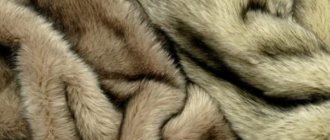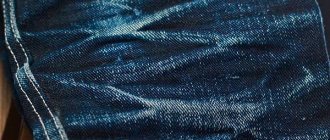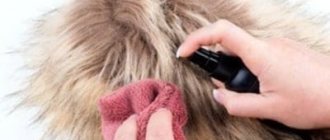When Cleaning Is Required
The service life of fur products with careful use is at least 10 years. During this time, the fur becomes dirty repeatedly. Untimely and improper cleaning can cause damage. But frequent procedures are not good for fur clothing. There is no schedule that would indicate the frequency of cleaning - everything is individual and depends on factors related to the appearance of the fur.
Cleaning is required if:
- there are spots uncharacteristic of the pile pattern;
- the fur has turned yellow, green or lost its shine;
- the color has lost its uniformity and smooth transitions;
- the pile has become greasy and greasy;
- the flesh became coarser and tougher.
Observe the behavior of the fur in windy weather. If the pile easily fits into its original place, the condition of the product is excellent. Pollution that requires attention is indicated by hairs that, after a blow of wind, do not return to their place, standing on end.
Features of cleaning white fur at home
There are many cleaning methods using various means - from folk to professional. When working with such a capricious texture, maximum care must be taken. Before you start using the product on the entire product, you need to test it on an inconspicuous area.
Light fur clothing looks beautiful, but is not considered the most practical
There are differences between cleaning faux and natural fur. When performing a wet procedure on natural leather, you need to process only the pile, without affecting the leather base, otherwise this may lead to damage to the item. Under no circumstances should you wet the flesh to which the hairs are attached, it will become oaky, crack, and the lint will fall out.
Contamination can only be cleaned with delicate products; under no circumstances should you use aggressive chemicals, powders with bleaches or enzymes.
Fur products should be dried naturally. Do not use a hair dryer, hot iron, or radiator.
Features when cleaning light and dark fur
To wash fur, you need to know which methods are suitable for a specific shade of the product in order to reduce the risk of damage to the product to zero. To do this, you should familiarize yourself with the list of prohibited products.
Exposure to dry compounds is an effective way to clean fur from dust:
- For dark fur, acceptable absorbents are hot sand, rye bran, sawdust and ground walnut shells. They remove dust and dirt from the pile, improving its appearance.
- For white products, cleaning with sand and walnut shells is fraught with staining, so preference should be given to starch, semolina and talc. Talc not only copes with the assigned cleaning tasks, but also neutralizes unpleasant odors.
- It is worth saying that talc is not recommended for dark fur. Small grains can settle on the hairs, which will lead to loss of shine, luster and natural color.
Dry washing powders are not acceptable for fur products of any shade.
Wet exposure is only permissible superficially, without affecting the interior. Light damp cleaning will help neutralize the oily sheen of dark fur. But light shades are more susceptible to yellowing, which cannot be removed without liquid compounds:
- Ammonia and vinegar are allowed for both light and dark products. Prohibited - acetone (the reaction of the lint is very unpredictable).
- Yellowing of light fur can be safely and quickly eliminated with hydrogen peroxide.
- Refined gasoline will help remove greasy shine from dark fur. It is strictly contraindicated for light shades - it cannot be used to restore the snow-white appearance; the condition may worsen, even to the point of irreparable yellowing.
The generally accepted measure for fur of any shade is to comb it with a comb with fine metal teeth. Comb as follows: Short and cut - against the grain, long - in the direction.
Methods for cleaning white fur
It can be cleaned wet or dry. The procedure consists of treating only contaminated areas or cleaning the entire product.
How to wet clean white fur at home
The wet method is acceptable mainly for faux fur products. Usually a soap solution is used as a detergent. The procedure will require a delicate product - shampoo or liquid soap, a basin, a soft bristle brush or sponge, a cotton napkin and a terry towel.
You need to pour water with a temperature of about 30 degrees into a basin, dilute the detergent in it to form foam. It is recommended to lay the product on a horizontal surface. If you need to clean the white fur on a jacket of small size and length, you can hang it on hangers.
Dip a brush or sponge into a bowl of soapy water. Carry out processing in the direction of the pile. After cleaning the stains, wet a cotton napkin, remove any remaining soap, then pat dry with a terry towel and dry at room temperature away from heat sources. After the item is completely dry, it can be combed with a comb with rounded teeth.
The easiest and most affordable way to clean faux fur is with a soap solution.
The easiest way to clean, if the item is small and almost completely dirty, is to wash it in a washing machine on a delicate cycle.
The wet method consists not only of using water and soap, but also of treating with alcohol, blue solution, vinegar, and ammonia.
We recommend reading: What are the benefits of peanut butter, composition and calorie content?
How to dry clean white fur at home
The dry method is more often used for cleaning natural fur, since the fur cannot be wetted. It consists of using bulk substances that have a porous structure and are capable of absorbing the particles that make up the pollution.
One of the dry cleaning agents for natural white fur coats is sawdust.
Wheat bran, talc, chalk, semolina, starch, and sawdust are suitable for this. The fur item is laid out on a horizontal surface, the product is scattered, and distributed evenly. When the dirt is absorbed, shake the product properly, comb out the residue using a sparse comb, or remove with a vacuum cleaner or brush. Short piles are brushed against the grain, long ones in the direction of hair growth.
Features when cleaning different types of fur
When planning to clean a fur product, carefully consider every step, from information about the type of fur to the nature of the stain. You cannot use one remedy for everyone.
There are recipes and conditions indicated for a specific type of pile:
Mink. Both wet and dry cleaning are allowed, but with gentle handling. Natural mink fur can be cleaned with 9% vinegar, medical alcohol and water. Ingredients in equal proportions. Residues are removed with a dry soft cloth. The solution is convenient when affecting large areas, as it is easily distributed from a spray bottle. A mixture of salt and ammonia will cope well with local problems. When dry cleaning, preference should be given to talc or sawdust, depending on the shade.
Rabbit, goat and wolf. The fur is easy to care for. The most popular method is cleaning with a mixture of ammonia, hydrogen peroxide and water (1 tbsp/3 drops/250 ml). The solution is applied to the product and left for 20 hours. Dry cleaning – with bran heated to 45-50 °C.
Chinchilla, otter, muskrat. Being classified as a dark species allows you to safely clean the fur at home. It is allowed to use pure but high-quality gasoline, as well as solutions based on an equal ratio of medical alcohol, vinegar essence and water. From the list of dry methods, cleaning with hot sand is ideal.
Sheepskin and astrakhan fur. A quick and effective way to clean sheepskin and astrakhan fur is hydrogen peroxide. It is not used in a pure state, but in a diluted state - a liter of water is taken per tablespoon. When applying, make sure that the liquid is distributed over the surface without penetrating deep into the core. Potato starch and aviation gasoline are the way to achieve excellent cleaning results.
Arctic fox, fox and silver fox. The list of acceptable cleaning methods is very long. This includes pure gasoline, shampoos for animals (dogs in particular), liquid detergents for washing silk, ammonia, and semolina. Yellowness is removed using peroxide.
Raccoon. Only dry cleaning or surface wet cleaning is allowed.
All methods are accompanied by mechanical combing and drying in a natural way, away from heating devices and direct sunlight.
Adding shine to fur
How to clean mink or arctic fox fur if it has lost its former shine? In order to return a fur coat or hat made of natural fur to its previous condition: rabbit, silver fox, chinchilla or sheepskin, you can use folk remedies that will solve your problems not only in, for example, how to clean the fur of an arctic fox, but also of any other animal.
Alcohol and ammonia
- Mix table vinegar and citric acid in a 1:1 ratio.
- Treat the fur.
- Let sit for 10 minutes.
- Remove the product thoroughly.
Fish fat
- To 1 liter of boiling water, add: 10–12 drops of ammonia, 100 grams of fish oil and 10 grams of dark laundry soap.
- Cool the solution to 30–35 degrees.
- Apply the solution to the fur.
- Leave for 5-10 minutes.
- Remove any remaining product.
What is the difference between light cleaning and deep cleaning?
The choice of intensity of the proposed cleaning depends on the degree of contamination of the fur.
Easy cleaning is used when the product is only slightly dusty and does not have a greasy sheen, yellowness, or unpleasant aroma.
Easy cleaning of natural fur at home can be called a preventive measure aimed at minimizing the amount of cleansing through deep and chemical influences.
To carry out the procedure it is enough:
- Wet the cotton cloth with plain water.
- Spread the material on a flat horizontal surface.
- Place fur on top, for example, a fur coat, pile side down.
- Knock the thing out with a clapper.
- Shake and dry.
The settling of rare dust particles and sand is not a reason for deep cleaning. It is carried out only when the clothes have lost their neat appearance and the fur has become greasy.
Cleaning is carried out in the following sequence:
- Gentle removal of dust using the knocking method.
- Removal of local contamination.
- Combing out dirt using a comb.
- Treat the surface with the selected cleaning agent.
- Repeated combing.
- If necessary, knocking out (indicated for dry cleaning) or drying (for wet cleaning).
For both light and deep cleaning, combing is recommended to maintain the correct direction of the pile.
How to wash a dark fur collar
Dark things tend to fade and so that you don’t have to think about how to paint the item later, it is better to clean the collar or pom-pom on the hat using the right products:
- Dissolve 1 tbsp in a liter of water. spoon of shampoo.
- Using a sponge, apply the product to the pile of your collar.
- After 15 minutes, rinse the item in warm water.
- Lay the collar on the fabric.
- Brush the collar while drying.
The product is excellent for hoods and collars made of dark fur: silver fox and chinchilla. The mixture will retain the color and you won’t have to think about how to dye your collar or hat with a pompom.
How to clean fur
Methods also differ based on the type of contamination. Yellowness, dust and grease can only be eliminated with the right selection of products.
Dry cleaning with starch
Starch is a popular absorbent used in cleaning fur.
The reason lies in affordability, security and speed of solving problems with its help.
To increase starch cleaning agents, it is recommended to heat it in the microwave or in a water bath. The maximum permissible temperature of the product is 80 °C.
Cleaning is carried out as follows:
- A large amount of starch is distributed along the front side.
- Using a dry, clean hand or cloth, rub the dry mixture onto and between the pile with gentle massaging movements.
- When the starch loses its whiteness, the product is knocked out to remove residues.
The procedure is repeated until a white shade is achieved - after cleaning, the starch should retain its original appearance. Upon completion, the fur is well knocked out and combed.
Semolina - to restore shine and remove dust
Semolina can surprise - in addition to being used in cooking, it is an excellent helper in the household. For example, it has shown itself to be excellent when cleaning fur: it does not spoil the lint and fur, removes dirt, and restores shine.
Using semolina when cleaning fur:
- Apply the cereal to the surface.
- Rub against the lint.
- When the shade of the semolina changes, begin removing it, combing it moving in the same direction as the pile.
- Shake to remove any remaining product.
Exposure to semolina is a quick method that does not require either heating the ingredients or mixing with other components. The cereal is good on its own. However, if the contamination is serious, it would not be a bad idea to strengthen the semolina by mixing it with gasoline or vinegar. As a result of mixing, the loose texture should be preserved.
Ammonia and hydrogen peroxide - from stains, dirt and oily shine
A multifunctional product aimed at neutralizing a wide range of problems ranging from dirt to oily shine.
Required:
- ammonia – 2-3 drops;
- hydrogen peroxide -1 tsp;
- water – 1 l.
Steps:
- Mix the ingredients and pour into a spray bottle.
- Distribute the solution over the surface.
- Remove dirt with a soft cloth and combing.
Don't forget to dry it properly and comb out the lint periodically.
Wheat or rye bran
Bran is not only a cleaning agent that removes dust, dirt and grease, but also a natural fragrance that eliminates unpleasant odors.
Application:
- Heat the bran in a dry frying pan.
- Distribute while hot on the surface.
- Distribute against the pile using massaging movements.
- Leave until cool.
Hot bran will quickly absorb dirt and grease, and all you have to do is shake out the product.
Shampoo for animals
It is logical to use detergents designed specifically for caring for pets when cleaning fur.
Suitable shampoos for cats and dogs. The recipe that uses shampoo is very simple and also includes water.
Cleaning:
- Dilute shampoo in a small amount of water.
- Beat until soft, fluffy foam is obtained.
- Apply foam to the area to be treated.
- Rub in with a soft sponge.
- Remove with a damp cloth.
- Brush and dry.
It is acceptable to use regular shampoo and dishwashing detergent. Only without aggressive components.
Household chemicals – compositions for cleaning fur
AVEL Hussard
InSaf
If you can’t trust traditional methods, take advantage of the gifts of chemical products. Fortunately, there are now a sufficient number of special compounds.
The following products have proven to be effective and safe:
- Ultra Finish Milk. Used to remove dust, add shine, restore softness and silkiness. Does not cause sticking. Simply spread over the surface and dry.
- AVEL Hussard Terre De Sommieres. Presented in powder form. Works great on greasy and oily marks. The only drawback is the price, which starts from 600 rubles. It is used like starch - spread, rub, knock out.
- InSaf. It has a wide range of effects - from antistatic properties to removing dirt and dust. Price from 150 rub.
Acceptable household chemicals do not include powder.
Is it possible to wash real fur?
When wondering about the permissibility of washing, feel free to reject any urge to such actions. Washing natural fur is prohibited - both by hand and in a machine. The mezdra, the so-called skin on which the pile rests, can become rough and crack when wet.
Deformation and baldness are the consequences of washing natural fur in a washing machine. The villi are pulled out of the skin, and deformation occurs not so much from exposure to temperature as from a humid environment. Therefore, even when carrying out wet washing, you should be extremely careful not to apply more solution than is required for surface cleaning.
Washing for natural fur is taboo. Other prohibitions include: drying with a hairdryer, in the sun and near heating devices; Ironing even from the inside out.
How to remove stains from fur
On fur products, as on other things, stains often appear that have a different nature of origin.
Fur can become stained, for example, from interaction with suede surfaces. It is also possible that stains may appear due to simple carelessness - blots from a pen, traces of sauces.
Problems with spots are solved based on the type of fur and its shade:
- Dark fur is restored to its original appearance with gasoline. It will remove grease from the collar and cuffs. It can be used both in pure form and in diluted form. Mix gasoline, starch or finely ground sawdust in equal parts - you should get the consistency of sour cream. Apply to the stain, wait 5 minutes and remove.
- The ink can only be removed with acetone, but given the unpredictable reaction, test drive it in an inconspicuous area.
- The problem that arises on light fur can be solved by mixing alcohol with starch or soda.
- Oil paint stains can be removed with vegetable oil.
- Lipstick, foundation can be used with medical alcohol.
- A mixture of ammonia and salt can deal with stains from grease and sweat.
If home treatment is not successful, the only way out of the situation is dry cleaning. Trained specialists will assess the situation and, based on the type of fur, type and complexity of the stain, will carry out dry cleaning with professional means.
Cleaning faux fur
There are several ways to clean faux fur:
Dish soap and starch
- It is necessary to mix until smooth: starch , dish soap and washing powder . Portions of ingredients should be equal .
- Apply the mixture to the stain.
- The product must dry.
- Shake the item, and then treat it with a comb with infrequent teeth.
Fabric soaked in gasoline
- Soak the fabric in gasoline.
- Check in an inconspicuous place how the product affects the fur.
- Wipe the stain with this rag.
- Treat the area with a damp sponge.
Additional recommendations
When cleaning light and dark fur, there are a lot of nuances, if not followed, the procedure can harm the appearance of the product. Fur may fade, losing its natural shine, if you clean a dark item with an overly concentrated solution of ammonia. And light shades are often susceptible to yellowing, which is often the cause of improper drying and selection of cleaning products.
What not to clean
The list of funds permitted for use has already been discussed several times. But a separate topic worth mentioning is the effects of substances that are unacceptable in relation to natural fur.
These include:
- household chemicals for rust removal;
- enzyme powders;
- bleaches;
- substances with an aggressive composition.
If you think that the problem cannot be solved without strong remedies, do not take risks and entrust the product to professionals working in dry cleaners.
How to get rid of dust
If the product becomes dusty during storage (the case does not provide 100% sealing), you should not immediately resort to drastic measures. There is a method that can quickly neutralize the problem.
First, try to solve everything peacefully using mechanical force - knocking it out with a clapper or using a vacuum cleaner for the keyboard.
If knocking out didn't work:
- Spread a cotton cloth lightly moistened with water on the floor.
- Place the product on top and knock it out on both sides.
Don't forget to comb it after cleaning. But don’t get carried away; excessive combing will not benefit the natural hair.
How to restore shine to fur
Loss of shine can be caused by both use and cleaning. Effective methods for restoring shine are:
- Treatment with lemon juice and table vinegar (1/1).
- Grated walnut kernels - the desired result is achieved thanks to the oil.
- Fish oil (100 g) in combination with laundry soap (10 g), boiling water (1 l) and alcohol (10 drops) will clean and restore shine. Processing while cooled.
- The return of shine is guaranteed by treatment with a vinegar solution.
A washing solution based on neutral hair shampoo and water will be a real salvation from oily sheen, which is unnatural for fur.
Having studied all the nuances and cleaning methods, you don’t have to worry about reducing the service life of the fur product.











